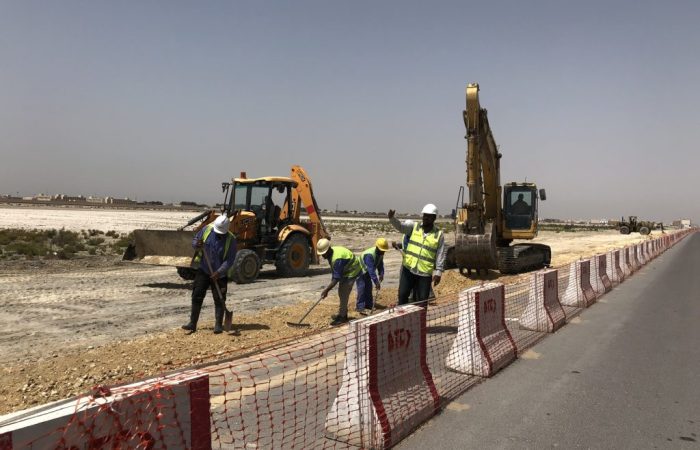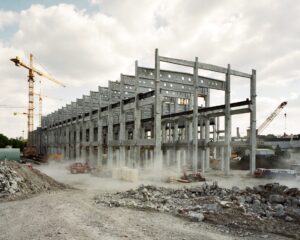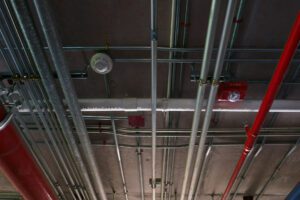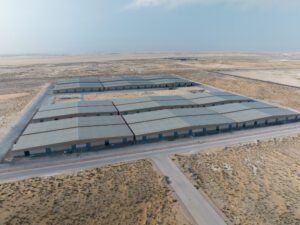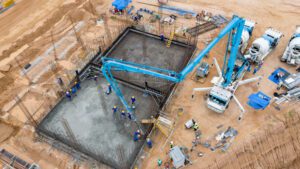In huge building projects, heavy machinery is employed for a variety of tasks. The scope of the job and the available budget determine the heavy machinery that will be used. When using them, the building may go more quickly and with less difficulty.
7 Best Machines For Construction
Excavators
An excavator is a vital piece of construction equipment. They are mostly used for excavating, but also for a wide variety of other tasks including heavy lifting, demolition, river dredging, tree cutting, etc.
When it comes to excavators, you can expect to find a lengthy arm and a storage compartment. A digging bucket is mounted on the end of the long arm, and the machine operator has a cabinet in which to work.
This whole cabin setup has the ability to rotate up to 360 degrees, making the process simpler. Wheeled and tracked versions of excavators are also commercially available.
Backhoe
The backhoe is another common piece of machinery because of its versatility. The hoe arrangement is located on the rear of the truck, as implied by the name, while the loading bucket is located up front.
For digging trenches under the machine’s ground level, this is a great tool since it allows for front bucket loading, unloading, and lifting.
Bulldozers
To dig down to a certain depth, bulldozers and other types of soil excavation equipment are utilized. The large metal plate with sharp edges at the front of the device is used to scrape dirt away.
Use hydraulic pistons to lower or lift the plate. These are often used in the processes of excavating weak soil or rock layers, elevating dirt, and so on.
Graders
Motor graders, or graders, are another tool used in the building trade and are utilized mostly in the paving of roads. Its primary function is to smooth out uneven terrain. There’s a horizontal blade that sinks into the ground between the vehicle’s front and back wheels. The cabin is mounted on top of the rear axle configuration, making it easily accessible for operation. A motor grader may also be used to clear snow or dirt off roadways, level the ground before asphalt is laid, or remove an unwanted soil layer.
Trenchers
To dig trenches in the ground, trenchers or trenching machinery are used. In most cases, these trenches are dug for the installation of pipes, cables, drains, and other infrastructure. There are two distinct types of trenching equipment: chain trenchers and wheeled trenchers.
Chain trenchers have a stationary long arm that the digging chain is wrapped around. Trenchers on wheels have a metal wheel outfitted with digging teeth. Wheeled trenchers are preferable for excavating dense soil layers.
Both kinds of trenchers may be purchased as either a tracked or wheeled vehicle.
Loaders
Loaders are essential on a construction site, where they are used to load materials into dumpers, trucks, and other vehicles. The materials might be anything from raw materials to excavated dirt to demolition debris.
The loader’s huge bucket is located up front, and the loader’s moving arm is quite short. A loader might have wheels or tracks. While wheeled loaders are ubiquitous, tracked or crawler loaders are used in areas that are inaccessible to their wheeled counterparts.
Crane Towers
Tower cranes are stationary cranes used for lifting heavy materials during the building of skyscrapers. Such machinery makes it simple to raise heavy objects to the desired height, such as pre-stressed concrete blocks, steel trusses, frames, etc.
A crane comprises a vertical tower called a mast, an operational arm called a jib, a counter jib that holds weight at the crane’s back, and a cabin for the operator to control everything.
Top construction equipment manufacturers
The Yellow Table, which is an annual ranking of the world’s construction equipment manufacturers by sales numbers represents the following top ten construction equipment manufacturers in the world.
Caterpillar
Caterpillar, located in the United States, has a commanding sales lead and is once again the leading construction equipment manufacturer in the world. The corporation contributed more than 16 percent to the overall revenues of the table.
Komatsu
Komatsu maintains its historic ranking as the second-largest producer of construction equipment. The revenues of the industrial behemoth increased in 2019.
Many of the 930E ultra-class electrical dump trucks were recently tested at a huge mine in Brazil as part of the company’s Autonomous Haulage System, which is part of its Smart Construction initiative.
John Deere
Due to the acquisition of the Wirtgen Group, John Deere surged from number nine on the list to number three, an unprecedented climb in the top 10. Due to robust sales of John Deere and Wirtgen brands, including Benninghove, Kleemann, Vogele, and Hamm, the business holds its position as the third-largest in the world in 2014.
XCMG
Despite Sany’s rapid ascent in the rankings, XCMG stays ahead of its Chinese rival, as the firm moves to fourth place.
To further increase sales, XCMG, which has a diverse product portfolio, is increasingly focusing on developed countries such as North America and Europe, as do many of the big Chinese OEMs.
Zoomlion
The Chinese company Zoomlion enters the top 10 for the first time after rising from number 13 on the list the previous year. The firm offers a wide variety of goods, including excavators, bulldozers, access equipment, concrete-related items, and drilling rigs.
Doosan
Doosan, a company headquartered in South Korea, maintains its position at number nine on this year’s Yellow Table. Similar to the bulk of OEMs, the corporation invests extensively in innovative technologies.
The business debuted the Concept-X control system at a demonstration in South Korea late last year; the technology is touted to allow the automation of any hazardous construction tasks.
Liebherr
The Liebherr company had good growth in construction equipment sales, but its position on the list did not change. Europe – and particularly Germany, France, Spain, and Denmark – had significant increases in sales, but sales in practically all other areas were also high.
North America, though, was claimed to have had the most improvements.
Hitachi
Hitachi, located in Japan, had construction equipment sales of $8.9 billion, a decrease from the previous year that drops the business from fourth to seventh place. Japan continues to be the greatest geographic market for corporate sales, but North America is quickly gaining ground.
Volvo CE
Volvo Construction Equipment (Volvo CE) has fallen from fifth to the sixth position. Volvo CE has committed to producing entirely electric small-wheeled loaders and excavators in the future, as opposed to diesel-powered alternatives.
Sany
Following a significant increase in construction equipment sales in 2019, Sany climbs from number seven to number five on the list. The corporation has never been ranked higher than number five on the Yellow Table.
Tips For Equipment Management
The usage ratio of each piece of equipment must be carefully monitored. This will indicate if the equipment is being used to its fullest capacity or whether it is sitting idle for too long in a warehouse.
Having access to this information has many advantages. If you see that equipment is being overworked, you may evaluate the related costs (such as increased wear and tear and decreased productivity on the job site) against the price of purchasing a second unit.
Alternatively, if a piece of equipment is underutilized, you may consider selling it and renting a similar item as required.
Any mechanical piece of construction equipment needs regular maintenance. Good software will assist you in planning maintenance to minimize project interruptions.
Frequently, it makes sense (from both a scheduling and equipment maintenance standpoint) to undertake inspections immediately after operating a piece of equipment on the job site.
If you rent out construction equipment, a good opportunity to do inspections is when a client returns the tools. Thus, you will also be able to hold them liable for anomalous equipment damage.
Construction equipment is capable of working far harder than people. However, its capacity is not unlimited. There are still significant practical limitations. For instance, jackhammers are available in various sizes. If you pick the wrong size, the equipment may not be able to complete the work within the specified time.
Consider your equipment fleet in light of the demands of your project to avoid these types of complications.
Take Away
Most construction projects need the use of the aforementioned heavy equipment, in addition to specialized tools. Having them close at hand facilitates the job and accelerates the completion of the project.
Construction equipment and labor management are extremely similar. In either scenario, the final objective is to maximize productivity within the constraints of the resources that are at one’s disposal.
These processes are often interwoven with one another as well. It is not unusual for pieces of machinery to basically follow people who are certified to handle them. This phenomenon occurs rather often.
This highlights the need of using construction equipment scheduling software that is capable of assisting you in seeing the complete flow of resource management, including the dependencies that exist between particular products and individuals.

